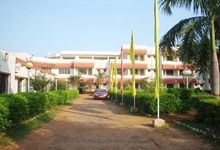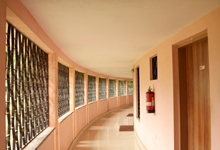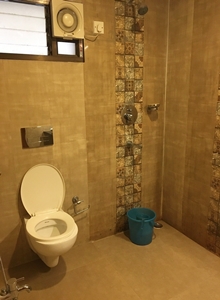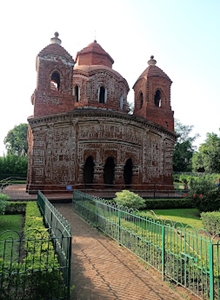BISHNUPUR
Bishnupur is a striking weekend gateway located in the Bankura district of Indian state of West Bengal. Bishnupur has developed as a popular tourist destination which can be ascertained by the presence of many beautiful temples with their intricate terracotta ornamentation. The grand view of these expansive square monuments with the curved roof of a Bengali hut styled which are inarguably the most thrilling architectures which are the main attractions of Bishnupur. Apart from these terracotta temples, Bishnupur is also famous for its Baluchari saris and its distinct style of music Bishnupur Gharana. Bishnupur has a glorious past that is emulated in its rich architecture, music and handicrafts such as pottery and weaving. Bishnupur prospered in the 17th and early 18th centuries and was ruled by a line of Hindu Rajas of the Malla dynasty. Bishnupur developed a unique form of architecture and has perhaps the most brilliant and detailed terracotta work in Eastern India that has withstood the ravages of time. These terracotta tiles depict stories from Ramayana and Mahabharata. Bishnupur is also known for its traditional handloom saris. Pottery, artefacts and even jewelry made of terracotta which is also very popular. The history of Bishnupur can be traced back to 694 AD, when King Raghunath founded the Malla dynasty. However, it was much later in 994 AD that the place was named Bishnupur. The name is derived from the name of the Hindu God Vishnu and majority of the people here belong to the ‘Vaishnava’ sect. Bishnupur is also famous for the school of Hindustani music flourished under royal patronage along with the Bishnupur School and Painting. This style of music is still being kept alive in local academics of music. For almost a thousand years it was the capital of the Malla kings of Mallabhum. The patronage of Malla king Veer Hambir and his successors Raja Raghunath Singha Dev and Bir Singha Dev made Bishnupur one of the principal centers of culture in Bengal.
General information:
Area: 20.6 sq. km.
Altitude: 59 meters
Temperature: Summer – Max 44 to Min 28 degree Celsius and Winter – Max 29 to Min 2.1 degree Celsius.
Rainfall: 14.3 cm (July – August)
Clothing: Summer – Tropical, winter – Light woolens.
Season: September to March
STD Code: 03244
Local watchable in Bishnupur:
Jorebangla Temple: The Jorebangla Temple at Bishnupur resembles two thatched huts joined together with a single tower. This Temple in brick was built by the Malla King Raghunath Singh in 1655. The structure was erected on one metre high platform using laterite bricks. The entire outer surface is decorated with terracotta plaques displaying various aspects of human life and culture, gods and goddesses, animals, floral and geometrical designs.
Dalmadal Canon: The cannon named as Dal Madol was built by the Malla kings to fight the Maratha invasion. This Cannon is near Chinomasta temple and is significant for the people of Bishnupur as well as Bengal. The cannon measures about 3.8 m in length and has a barrel of 28.5 cm. It was built in the year 1742 under Raja Gopal Singh to protect Bishnupur from Marathas. The Cannon is built with iron materials and doesn’t have any rust, though it is exposed to rain and sun since 18th century.
Madan Mohan Temple: The Madan Mohan Temple of Bishnupur is a Hindu temple situated in Bankura district. This temple is dedicated to Lord Krishna. ‘Madan Mohan’ is another name of Lord Krishna. This temple was built by King Durjana Singh Deva of Malla Dynasty in the year 1694. It is one of the largest temples of Bishnupur. It is made up of brick with terracotta tablets cladding the walls, portico and pillars of the temple.
Rashmancha: The Rasmancha pavilion used for housing the idols of Lord Krishna from other temples during the Rash festival and was built in brick by King Veer Hambir in 1600 A.D. This is the oldest brick temple in Bishnupur and is shaped as an elongated pyramidal tower surrounded by hut-shaped turrets. The outermost gallery is elegantly surrounded by Bengal hut-type roofs. The floor is paved with bricks. The entire structure stands on a high platform made up of laterite blocks.
Malleshwar Temple: The only Shiv temple of Bishnupur is Malleshwar Shiv temple. Malleshwar Temple at Bishnupur is a laterite temple facing west. It was built by Malla King Bir Singha in 1622 and is one of the earliest temples of Bishnupur.
Lalji Temple: Lalji Temple at Bishnupur was built by Malla King Bir Singha II. Lalji Temple has been dedicated to Radha-Krishna and is built in similar Bengali architectural style with ornamental stucco decorations. At the front of the temple there is a dancing hall and a tower in the west dedicated to Raghunath.
Mrinmoyee Mandir (03 km): Mrinmoyee Devi temple is so far the oldest temple of Bishnupur dedicated to Goddess Mrinmoyee and probably the oldest Durga of Bengal. This temple was built in the year 997 AD by King Jagat Malla and it lies on the northern side of an old banyan tree. After the establishment of this temple the Malla dynasty started to expand their territory in and around Bishnupur. After that gradually the kingdom started to expand and new roads and settlements were constructed.
Shyam Rai Temple (07 km): The Shyam Rai Temple at Bishnupur has the most intricate sculptural details amongst all the temples at Bishnupur. Shyam Rai Temple was built in the year 1643 during the reign of Malla King Raghunath Singh and the period was regarded as the height of terracotta works of Bishnupur as the architectural style is of Pancha Ratna (meaning five gems) architecture in which there are four small towers and one main tower that builds the Temple. The walls are richly decorated with terracotta carvings featuring aspects of Lord Krishna’s life and are a highly prioritized monument of the Archaeological Survey of India.
Malla King’s Fort Gate (3.5 km): There are two massive sized gates present here which are supposed to be one of the entrance points of the erstwhile Malla kings’ fort and falls on the way to Mrinmoyee and Jiu temple. This is a great spot for history lovers traveling to Bishnupur as there is a huge gate built by the kings marking the entrance to their kingdom.
Jogesh Chandra Pura Kirti Bhawan Museum: This museum at Bishnupur is a place where one can relate to art and archaeology as one will get to see tools from Mesolithic and Palaeolithic era, metal ornaments and terracotta sculptures. Apart from these one can also spot coins and artefacts dating back to the times of Pushana, Sunga, Gupta, and Pala era.
Nandalal Temple: The Nandalal Temple is another example of terracotta art at Bishnupur, built on a square ground with one tower resting on the roof. The Nandalal Temple is a south facing temple and was built around 17th century.
Lalji Temple: Lalji Temple at Bishnupur was built by Malla King Bir Singha in the year 1658. The temple was built on a raised platform with a dome shaped rising tower on the top. The walls of the temple are beautifully ornamented with stucco decorations and are also an example of Bengali architecture or ‘Eka-Ratna’ temple.
Madan Mohan Temple: Madan Mohan Temple at Bishnupur was built by Malla King Durjan Singh Dev in the late 17th century that is 1694 AD within the fort complex. This is also of ‘Eka-Ratna’ styled Bengali architecture with a square flat roof, cornices that are curved and a pinnacle on the top. The Madan Mohan Temple is one of the oldest temples at Bishnupur where the deity is still there in the temple and is also worshipped.
Radhashyam Temple (Mandir): Radhashyam Temple is also an ‘Eka-Ratna’ styled architectural temple built by Malla Ruler Chaitanya Singha in 1758 AD. This is a south facing temple with a square curved roof structure and a single tower and a fluted dome on top. The dome shaped pinnacle on the top is slightly different from other Ekaratna temples at Bishnupur and the walls are also decorated with fine elaborate stucco.
Kalachand Temple: The Kalachand Temple at Bishnupur built by Malla King Raghunath Singha in the year 1656 was completely built in Makra stones. The rooftop is designed in fantastic chala style of Bengal architectural design with resplendent terracotta carvings. The top of the temple has strange prolonged pyramid tower, encompassed by cabin molded turrets.
Radha Govinda Temple: The Radha Govinda Temple at Bishnupur is another example of the fine terracotta architecture built by Malla King Krishna Singh in 1729 AD. The Radha Govinda Temple is also of ‘Eka-Ratna’ styled temple which is of the thatched-hut fashion of Bengal Temple architecture with a curvilinear tower at the top and the walls are beautifully decorated with stucco designs. A beautiful stone chariot is placed within the temple compound.
Festivals of Bishnupur:
Jhapan (Shravana Sankranti/ Mid-August): The most important festival of Bishnupur is Jhapan, held in the glory of Manasa, the daughter of Shiva and goddess of Snakes. Jhapan represents the snake worship cult in Bengal. It is basically a regional harvest festival and closely associated with the fertility cult too. Amidst chanting of hymns in glory of Goddess Manasa, groups of snake charmers demonstrate tricks and feats with poisonous snakes. Jhapan literally means a stage erected to exhibit tricks with snakes. Charmers, called Jhampanias, bring many deadly and venomous snakes in baskets made of cane, bamboo or grass, to the old palace ground. Jhapan festival began as a grand reception first given to Bir Hambir Malla on his return after battle.
The Bishnupur Mela: It is held every year around the last week of December, near the Madanmohan Temple. This fair stretches over four days and people from all the nearby villages come together to celebrate the end of the agricultural season.
Bishnupur Utsav: A recent addition is the Bishnupur Utsav, held immediately after the Bishnupur Mela (fair). It is a classical music and dance festival in recognition of the Bishnupur Gharana in music.
Indra Puja (Bhadra/ August – September): Another colourful festival held at Bishnupur with great pomp is the Indra puja or the Indra Parab. On this occasion the Malla Raja of Bishnupur presents yellow turbans to local Santal chiefs.
Gajan (March to April): Gajan festival begins at the end of a week culminating in month long rural fairs on Shivaratri day and is a popular festival of Rural Bengal. The festival at the Bahulara Siddheswar Shiva Temple (25 km away) and the fair draws large crowds from distant places.
Arts and Crafts of Bishnupur:
The local handicrafts of Bishnupur include Silk, Tussar Silk, Conch Shell wares and Bell Metal wares. No less important from the point of view of popular taste of the fine sweetmeats and flavoured tobacco of Bishnupur.
Bishnupur is also famous for terracotta folk toys like the Bankura (rather Panchmura) horse and clay dolls.
Bishnupur Silk is among the finest in the world.
Terracotta, metal ware and temples characterise Bishnupur. The temples are built mostly of bricks and at times, of laterite. The architecture is modelled on the pattern of Bengali huts built of bamboo and mud and roofed with thatch.
Bishnupur will remain ever famous for its distinct style of music, i.e. Bishnupur Gharana, if not anything else. The name of Jadu Bhatt, the music teacher to Rabindranath Tagore is remembered with respect to this day.
How to reach:
Air: Nearest Airport to Bishnupur is Kolkata Airport (Netaji Subhas Chandra Bose International Airport) which is located 216 km away from Bishnupur.
Rail: Bishnupur Railway station is well connected with Kolkata and Howrah by strong railway networks. Trains are available from Howrah to Bishnupur.
Road: Bishnupur is well-connected by regular bus service to Kolkata which is 151 km away which is only 03 hour drive, Durgapur 81 km, Purulia 145 km, Bankura 34 km, Kharagpur 91 km etc. Local transport: cars on hire can be arranged for sightseeing.
Best time to visit: Though Bishnupur can be visited throughout the year, but the best time is from September to March, as climate remains clear and tourist can comfortably visit the local sightseeing.












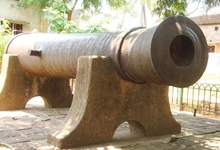
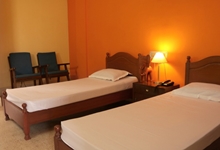




BISHNUPUR TOURISM PROPERTY – EARLIER BISHNUPUR TOURIST LODGE
Bishnupur Tourism Property was also known Bishnupur Tourist Lodge earlier is one of the best and prime accommodations available in the town of Bishnupur at Bankura district. Bishnupur Tourism Property or Bishnupur Tourist Lodge is located at stone throwing distance from the iconic structure ‘Rash Mancha’. Bishnupur Tourism Property or Bishnupur Tourist Lodge is maintained by WDTDCL. Bishbupur Tourism Property or Bishnupur Tourist Lodge is spread over a vast area with big garden and sitting arrangements. The surrounding ambience of Bishnupur Tourism Property or Bishnupur Tourist Lodge is clean, well maintained and spacious. Rooms are equipped with all sorts of modern amenities along with restaurant facility is also available. The staffs are very well behaved and helpful towards serving the tourists. Bishnupur Tourism Property or Bishnupur Tourist Lodge is divided into both main building and annex building.
Amenities available:
All rooms are well furnished with modern amenities.
Rooms are equipped with attached western toilets.
Hot and cold water available.
Room service available.
All the rooms are equipped with AC facility.
Laundry facility available.
Tariffs:
A.C Deluxe Double Bedded Room – First Floor (Annex Bldng): 2200/-
A.C Deluxe Double Bedded Room – Ground Floor (Annex Bldng): 2200/-
A.C Deluxe Double Bedded Room – Ground Floor (Main Bldng): 2200/-
A.C Deluxe Double Bedded Room – Second Floor (Annex Bldng): 2200/-
A.C. Large Double Bedded Room – First Floor (Annex Bldng): 3200/-
GST and Taxes as applicable, payable at spot.
20% on room for extra person charge.
20% discount on room rent for senior citizens.
HOW TO BOOK: Call 9831311606 , 9830381306 and get the current rooms availability status or use the query form below.
Or visit us at 8C Shanti Ghosh Street, Kolkata – 700003, near Manindra Chandra College. Or drop your query by Whats app in the above numbers.
